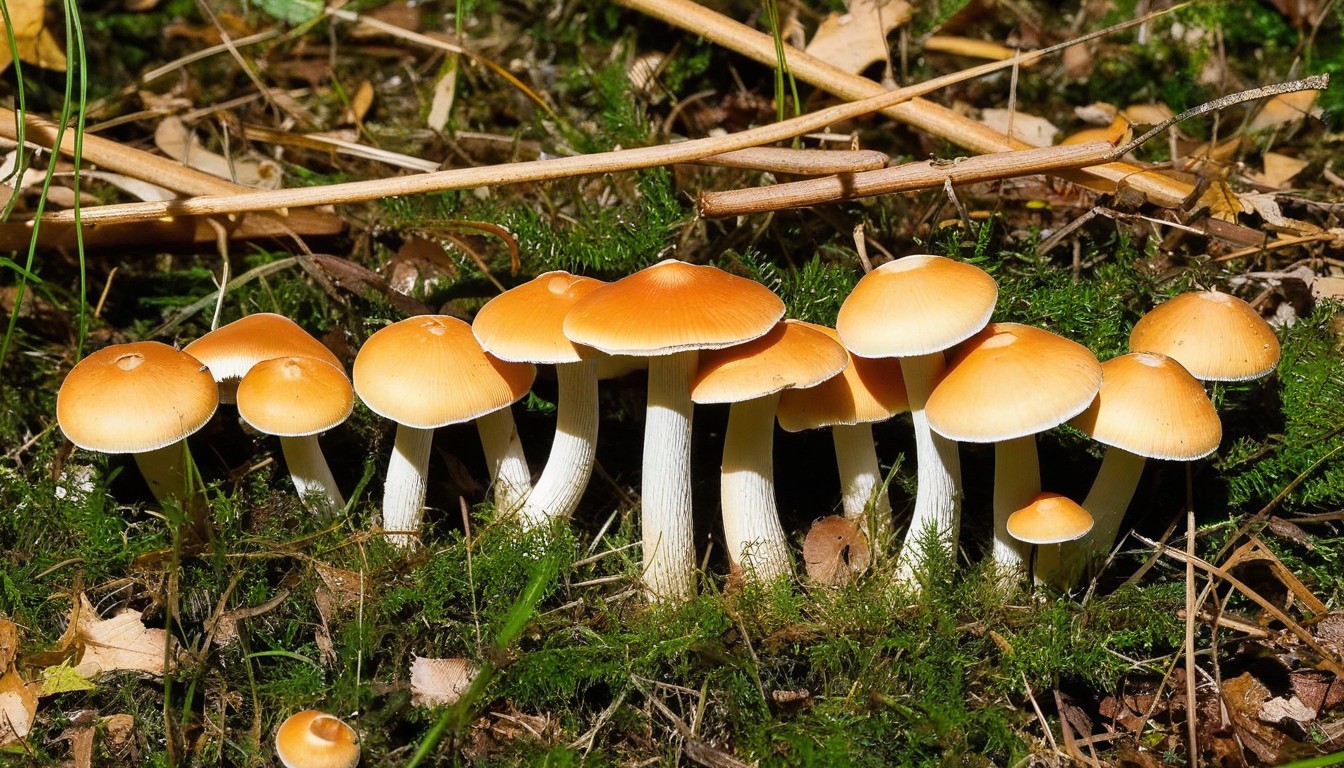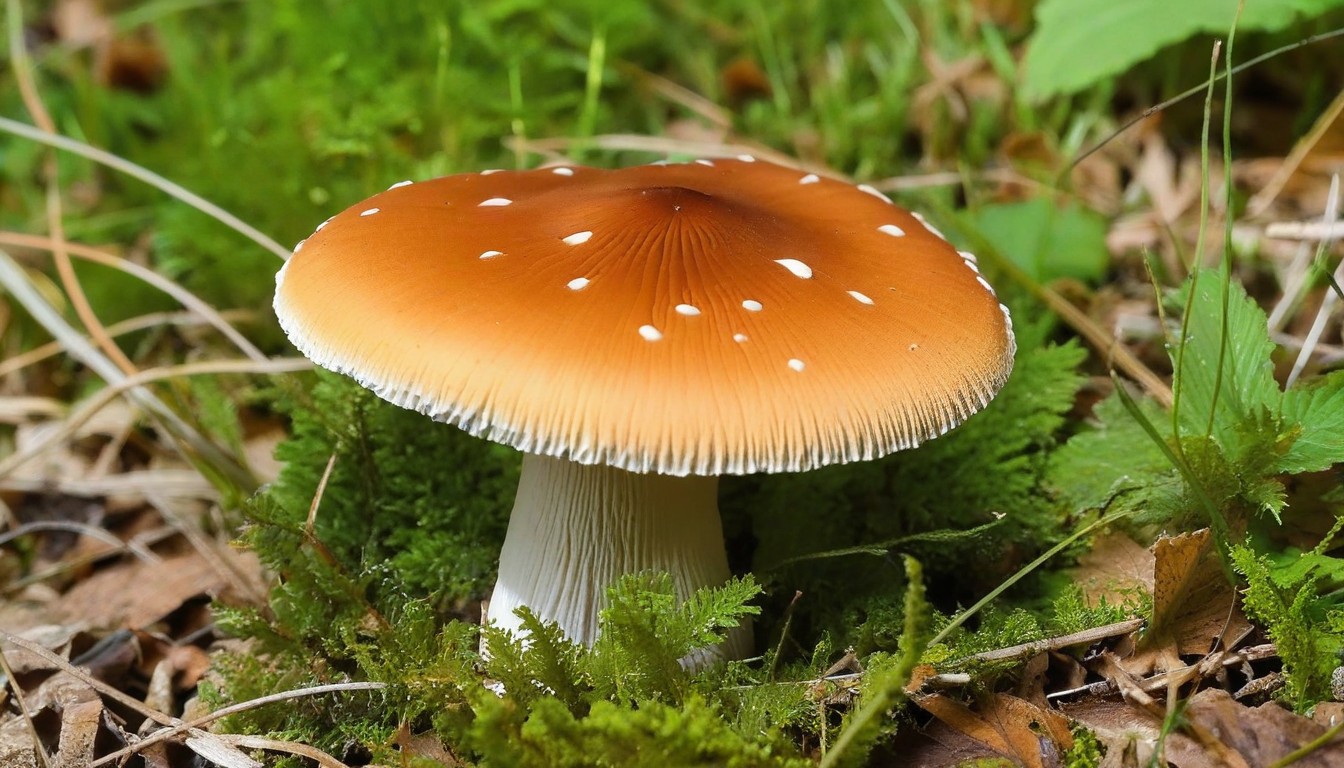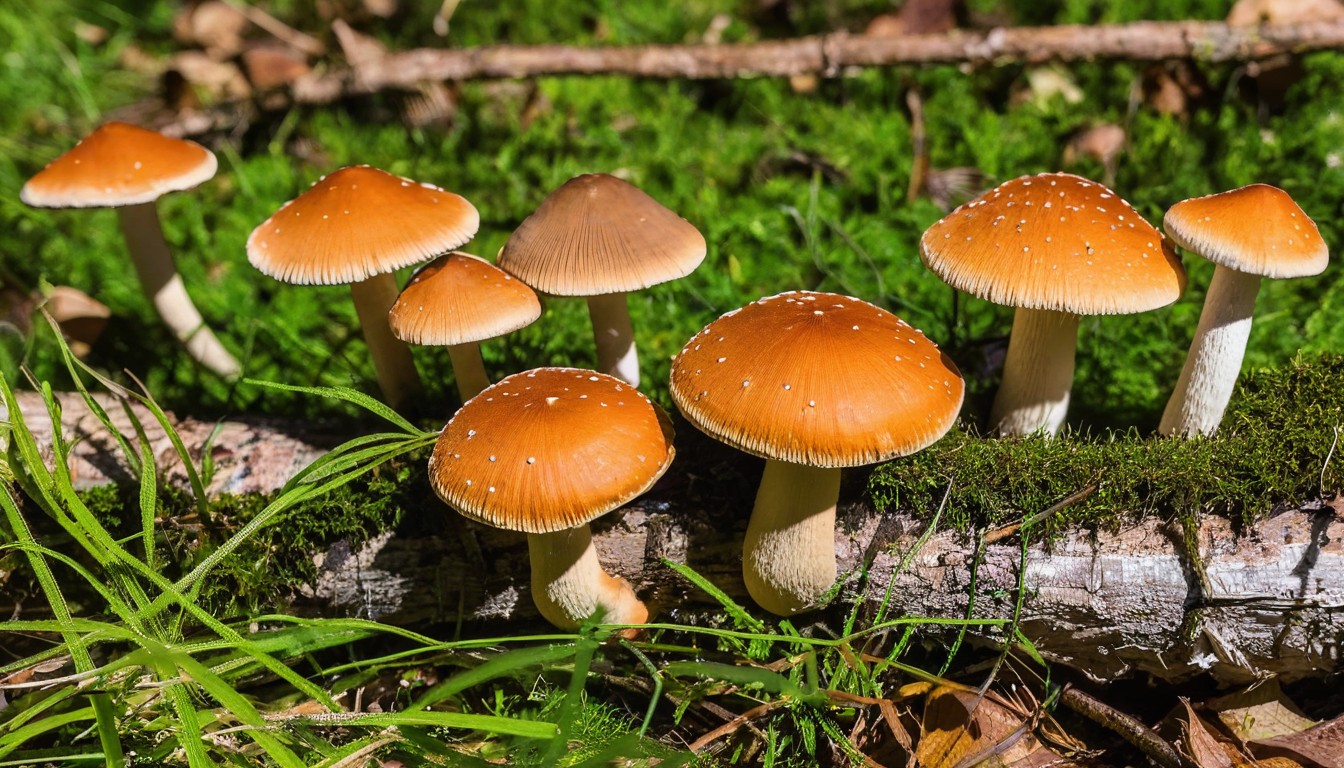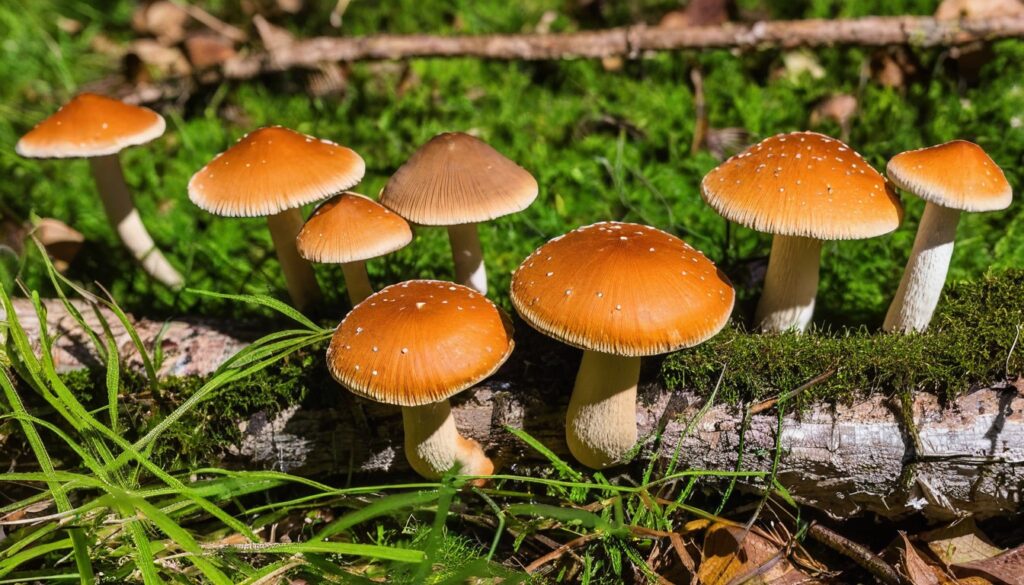If you live in Massachusetts or plan to visit the state, you’ll be glad to know that it’s home to a vast array of mushroom species. Whether you’re an enthusiastic forager or just curious about the local fungal diversity, this comprehensive guide will help you discover and identify some of the common mushrooms you may come across. From edible mushrooms to toxic species, we’ve got you covered.
Key Takeaways:
- Massachusetts is home to a variety of mushroom species.
- This guide contains information on how to identify common mushrooms.
- The guide explores edible, toxic, medicinal, and rare mushrooms found in Massachusetts.
- For those interested in foraging, the guide also includes tips on mushroom hunting and the regulations to consider.
- The guide suggests cultivated techniques for interested readers to grow mushrooms in Massachusetts.
Understanding Mushroom Identification
Identifying mushrooms can be a challenging task, especially if you’re not familiar with the characteristics that differentiate one species from another. Before venturing into the woods to hunt for mushrooms, it’s essential to understand the basics of mushroom identification. In this section, we’ll cover some key features to look for when identifying mushrooms in Massachusetts.
Cap Shape
The cap shape of a mushroom is one of the easiest ways to identify a particular species. Mushrooms come in different shapes, including bell-shaped, conical, flat, and convex. Some mushrooms, such as the Fly Agaric, have a distinctive rounded cap with wavy edges, while others, like the Chanterelle, have a wavy or folded cap.
Color
The color of a mushroom’s cap and stem can also provide useful clues for identification. Some mushrooms, like the bright-orange Chicken of the Woods, have a vibrant hue, while others, such as the Oyster mushroom, have a more subdued or earthy color. Additionally, some mushrooms change color when they mature or get damaged, which can also be a helpful identification feature.
Gills
The gills of a mushroom are the thin, blade-like structures that protrude from the underside of the cap. The number, shape, and color of the gills can vary widely between different species. For example, some mushrooms have crowded gills that are attached to the stem, while others have widely spaced gills that are free from the stem. The color of the gills can also range from white to brown to black.
Stem Structure
The stem of a mushroom, also known as the stalk, can vary in shape, length, and thickness, depending on the species. Some mushrooms have a thick, sturdy stem that is central to the cap, while others have a fragile, wiry stem that is offset from the cap’s center. Additionally, the texture, color, and surface of the stem can provide additional clues for identification.
By considering these key features and using a reliable mushroom identification guide, you can confidently identify the mushrooms you encounter in the forests and habitats throughout Massachusetts.
Edible Mushrooms of Massachusetts
Massachusetts is home to a diverse range of edible mushrooms, many of which are as delicious as they are healthy. Below is a list of some of the most commonly found edible mushrooms in Massachusetts, as well as tips on how to identify and prepare them:
Chanterelle (Cantharellus cibarius)
|
Appearance |
Tips |
Cooking Methods |
|---|---|---|
|
The golden yellow to orange cap is vase-shaped with wavy, irregular edges and vein-like ridges. The stem is the same color as the cap and has a ridged, wrinkled texture. |
Look for Chanterelles in hardwood forests, under oak, hickory, or beech trees. They are typically found from July to September. |
Sauté in butter with garlic and parsley or add them to risotto or pasta dishes. |
Hen-of-the-Woods (Grifola frondosa)
|
Appearance |
Tips |
Cooking Methods |
|---|---|---|
|
The large, fan-shaped cap is made up of overlapping layers of fronds that resemble a hen’s ruffled feathers. The stem is short and stubby, fusing with the base of the mushroom. |
Look for Hen-of-the-Woods in the woods, often near the base of trees like oak or maple. They grow in the fall. |
Roast in the oven with olive oil and garlic or add them to soup or stir-fry recipes. |
Black Trumpet (Craterellus cornucopioides)
|
Appearance |
Tips |
Cooking Methods |
|---|---|---|
|
The small, trumpet-shaped cap is black or dark brown, and the stem is thin and hollow, with a black or charcoal gray color. |
Look for Black Trumpets in hardwood forests, growing on the ground around oak and beech trees. They appear from late June to October. |
Sauté with shallots and thyme or add them to risotto, pasta, or egg dishes. |
When foraging for mushrooms in Massachusetts, always follow safety guidelines and regulations, and be sure to accurately identify any mushrooms before consuming them. By learning more about Massachusetts’ edible mushrooms, you can enhance your appreciation of the state’s rich fungal diversity while enjoying delicious, healthy meals.
Toxic Mushrooms to Avoid in Massachusetts
If you’re planning to forage for mushrooms in Massachusetts, it’s important to be aware of the toxic species that can cause serious health issues and even be fatal. Amanita mushrooms are among the most toxic and can be found in various habitats, including forests, lawns, and urban areas. These mushrooms contain a potent toxin called amatoxin that can cause severe liver and kidney damage. The infamous Death Cap mushroom, also a member of the Amanita family, is responsible for most mushroom poisonings worldwide.
Another toxic mushroom to avoid is the False Morel, which can be mistaken for the highly prized Morel mushroom. False Morels contain gyromitrin, a toxin that can cause gastrointestinal distress, headache, dizziness, seizures, and even comas when ingested. While some people consume False Morels after boiling or cooking them for a long time, it’s best to avoid these mushrooms altogether.
|
Mushroom Name |
Toxicity Level |
Description |
|---|---|---|
|
Amanita |
Highly Toxic |
One of the most poisonous mushrooms; contain amatoxin. |
|
Death Cap |
Highly Toxic |
Possibly the deadliest mushroom worldwide; contain amatoxin. |
|
False Morel |
Highly Toxic |
Can be mistaken for the highly prized Morel mushroom; contain gyromitrin. |
To avoid any potential harm, always research and verify any mushroom before consuming it. In case of accidental ingestion of a toxic mushroom, seek medical attention immediately. With proper knowledge and caution, you can safely enjoy the bountiful diversity of mushrooms in Massachusetts.
Medicinal Mushrooms of Massachusetts

While commonly known for their culinary use, mushrooms are also revered for their medicinal properties. Massachusetts is home to an array of medicinal mushrooms, each with its own unique health benefits.
Turkey Tail
A common medicinal mushroom found in Massachusetts is the Turkey Tail. This mushroom is known for its immunity-boosting properties, helping to fight off infections and diseases. It contains polysaccharides, which help to stimulate the immune system. Turkey Tail can be consumed in tea or capsule form.
Reishi
Another medicinal mushroom found in Massachusetts is the Reishi mushroom. This mushroom is adaptogenic, meaning it can help the body adapt to stress. It is known for its anti-inflammatory, anti-tumor, and anti-viral properties. Reishi can be consumed in tea or capsule form.
Chaga
The Chaga mushroom is another medicinal mushroom found in Massachusetts. It is known for its anti-inflammatory properties and is commonly used to support the immune system. Chaga can be consumed in tea or capsule form.
Lion’s Mane
Lion’s Mane is a unique medicinal mushroom found in Massachusetts. It is known for its ability to support cognitive function, helping to improve memory and focus. It can also enhance nerve function and promote healthy digestion. Lion’s Mane can be consumed in tea or capsule form.
Common Medicinal Mushrooms in Massachusetts
|
Mushroom Name |
Health Benefits |
|---|---|
|
Turkey Tail |
Immunity-boosting, fights infections and diseases |
|
Reishi |
Adaptogenic, anti-inflammatory, anti-tumor, anti-viral |
|
Chaga |
Anti-inflammatory, supports immune system |
|
Lion’s Mane |
Supports cognitive function, enhances nerve function, promotes healthy digestion |
As always, it is important to consult with a healthcare professional before incorporating medicinal mushrooms into your routine. With their numerous health benefits, exploring the world of medicinal mushrooms can be an exciting and beneficial journey.
Mushroom Foraging in Massachusetts: Tips and Regulations

If you’re a nature enthusiast or a foodie, you might want to try your hand at mushroom foraging in Massachusetts. The state is home to a variety of edible species, including prized fungi like the Chanterelle and Hen-of-the-Woods. However, foraging for wild mushrooms comes with risks, including the potential to consume toxic varieties. To ensure a safe and sustainable foraging experience, it’s important to familiarize yourself with the regulations and best practices for mushroom hunting in Massachusetts.
Legal Considerations
Before you hit the trails, it’s essential to be aware of the regulations for mushroom foraging in Massachusetts. In general, foraging on private property without permission is illegal. Additionally, some parks and conservation areas have specific rules about collecting wild mushrooms. For example, the Trustees of Reservations, a non-profit land conservation organization that manages several nature reserves in the state, has guidelines for foraging at their sites. Be sure to check the regulations for the area where you plan to forage, and obtain the necessary permits, if applicable.
Best Practices
When mushroom hunting, it’s important to follow responsible foraging practices to protect the environment and ensure the sustainability of future harvests. Here are some tips to keep in mind:
- Leave No Trace: Take only what you need and leave the rest for other foragers, animals, and the ecosystem.
- Know Your Species: Be sure you can confidently identify the mushrooms you’re picking, both for your safety and to avoid harvesting rare or protected species.
- Avoid Overharvesting: Don’t take more than you need, and avoid picking all the mushrooms in a given area to allow for future growth and reproduction.
- Use Proper Equipment: Bring a basket or cloth bag for carrying mushrooms to prevent them from getting crushed, and use a sharp knife or scissors to cleanly cut the mushrooms at the base of the stem.
Recommended Locations
Massachusetts is home to a variety of habitats where mushrooms thrive. Some of the best places to forage for mushrooms in the state include:
|
Location |
Common Mushroom Species |
|---|---|
|
The Berkshires |
Chanterelles, Hen-of-the-Woods, Lobster Mushrooms |
|
MetroWest |
Chicken of the Woods, Black Trumpet |
|
The Cape and Islands |
Oysters mushrooms, Puffballs, Blue Chanterelles |
Whether you’re a seasoned forager or a newbie, Massachusetts offers plenty of opportunities to explore the world of wild mushrooms. By following the regulations, best practices, and recommended locations, you can safely and responsibly enjoy the culinary and natural wonders of the state’s mushroom diversity.
Unique Mushroom Habitats in Massachusetts

Massachusetts is home to a diverse range of mushroom habitats, each with its own unique ecological conditions that support the growth of different fungal species.
Deciduous Forests
Many of the common mushrooms found in Massachusetts thrive in deciduous forests, where the soil tends to be rich in organic matter and moisture levels are optimal for fungal growth. Look for species like the gorgeous Red-Belted Polypore, which colonizes maple and birch trees, among others.
Wetlands
Wetlands are also rich in mushroom diversity, thanks to their nutrient-rich soil and consistent moisture levels. Keep an eye out for the striking Chicken-of-the-Woods, which has vibrant yellow-orange caps and grows on the dead or dying wood of hardwood trees.
Meadows and Fields
Open meadows and fields can be hotspots for mushroom activity in Massachusetts, particularly during the fall and spring seasons. You might find the delicious and sought-after Morel mushroom growing in mulch-rich gardens or disturbed soil.
Coastal Areas
Coastal areas offer unique fungal habitats due to their proximity to the ocean and the resulting influence of salt in the soil. Sea Laver, also known as Nori, is a type of edible seaweed that grows in rocky intertidal zones. While it’s not technically a mushroom, it’s a fascinating example of the different types of fungal-inspired foods available in Massachusetts.
“Mushroom habitats in Massachusetts are diverse, with each ecosystem containing its own unique fungal communities that contribute to the state’s fascinating fungal diversity.”
Rare and Protected Mushrooms in Massachusetts
Massachusetts is home to a diverse array of fungi, some of Which are considered rare or protected due to their ecological significance and vulnerability. These unique species are vital to maintaining the state’s biodiversity and require special attention and care to ensure their continued survival.
Rare Mushrooms in Massachusetts
One of the rarest mushrooms found in Massachusetts is the Eastern Pygmy Club, or Pseudoclitocybe cyathiformis. This tiny mushroom stands only a few millimeters tall and can be easily missed by the naked eye. It typically appears in clusters on the decomposing leaves and wood of hardwood trees in late summer and autumn. The Eastern Pygmy Club is considered nationally rare, with very few known locations in New England, making it a highly sought-after species for mushroom enthusiasts.
An interesting mushroom protected under Massachusetts law is the Violet-toothed Polypore, or Trichaptum biforme. This fungal species plays a vital ecological role in decomposing hardwoods and is often a sign of healthy and diverse forest ecosystems. Due to its ecological importance, the Violet-toothed Polypore is protected under the state’s Endangered Species Act, meaning it cannot be sold, transported, or disturbed without a permit.
Protected Mushrooms in Massachusetts
Some of the protected mushrooms in Massachusetts include the Smooth chanterelle, or Cantharellus lateritius, and the Golden Chanterelle, or Cantharellus cibarius. These delicious mushrooms are commonly found in the state’s forests in late summer and early autumn and are prized for their delicate flavor. However, they are also highly vulnerable to over-harvesting and habitat destruction, which can lead to their decline. To protect these important species, Massachusetts prohibits the commercial sale of wild harvested chanterelles, and only small amounts can be legally harvested for personal consumption.
In conclusion, rare and protected mushrooms in Massachusetts are a crucial part of the state’s biodiversity, and their preservation is essential for maintaining healthy ecosystems. By understanding and respecting these unique species, we can all contribute to the protection and sustainability of our local fungal communities.
Mushroom Cultivation in Massachusetts

Have you ever wondered about cultivating your own mushrooms in Massachusetts? You can grow a variety of different mushrooms, including Shiitake, Oyster, and Lion’s Mane, all with unique flavors and medicinal properties. Here’s a brief overview of some techniques and tips for successful mushroom cultivation in Massachusetts:
Mushroom Cultivation Techniques
Mushroom cultivation can be done indoors or outdoors, making it a versatile option for many. The following are a few popular methods:
- Indoor cultivation: This technique involves using substrate, a sterilized growing medium, and spores or a pre-grown mushroom culture in a controlled environment. You can use a fruiting chamber or a commercial kit, such as a Back to the Roots kit, to start your indoor cultivation.
- Outdoor cultivation: This technique involves preparing a suitable growing bed by mixing sawdust, straw, or wood chips with spawn or mushroom culture. Then, keep the bed moist and in a shaded spot. You can use logs or bags to grow different types of mushrooms, such as Shiitake or Oyster.
General Cultivation Tips
Regardless of which method you choose for cultivating mushrooms, keep the following tips in mind:
- Ensure proper sanitation and sterilization techniques to avoid contamination during the cultivation process.
- Choose a suitable location that has good ventilation, controlled temperature, and proper lighting.
- Keep the growing medium moist and monitor the humidity levels to create a suitable environment for the mushrooms to grow.
- Harvest the mushrooms at the right time, depending on the type of mushroom and its growth cycle.
Regulations
When cultivating mushrooms in Massachusetts, it’s essential to consider the regulations around it. For example, if you’re planning to sell your mushrooms, you need to follow strict guidelines and obtain the necessary permits from the Massachusetts Department of Agricultural Resources. Additionally, some areas may have restrictions on certain types of mushroom cultivation, so it’s vital to research beforehand.
Conclusion
In conclusion, Massachusetts serves as a prime destination for mushroom enthusiasts, offering a diverse range of common mushrooms. By understanding the distinguishing features of edible, toxic, and rare species, one can safely appreciate the wonders of the local fungal kingdom.
Apart from their culinary use, mushrooms provide various medicinal benefits, including boosting immunity and aiding in stress management. By incorporating these fungi into our diets, we can take advantage of their unique properties to support our overall wellness.
It’s important to remember that foraging for mushrooms in Massachusetts requires adherence to regulations and responsible practices. By respecting mushroom habitats and following legal guidelines, we can ensure the continued preservation of these remarkable organisms.
Whether you’re interested in foraging for wild mushrooms or cultivating your own, the resources available in Massachusetts make it an ideal location for mushroom exploration.
FAQ
What are common mushrooms in Massachusetts?
Common mushrooms in Massachusetts include species such as the Chanterelle, Hen-of-the-Woods, and many others that thrive in the forests and habitats of the state.
How can I identify mushrooms in Massachusetts?
Mushroom identification in Massachusetts involves observing key features like cap shape, color, gills, and stem structure. Understanding these characteristics can assist you in correctly identifying the mushrooms you come across.
Are there edible mushrooms in Massachusetts?
Yes, Massachusetts is home to a variety of edible mushrooms that can be safely consumed. Some examples of edible mushrooms found in the state are the Chanterelle and the Hen-of-the-Woods.
What toxic mushrooms should I avoid in Massachusetts?
It’s important to be aware of toxic mushrooms in Massachusetts, such as the Death Cap and certain Amanita species. These mushrooms can be dangerous if ingested, so it’s essential to avoid them.
Are there medicinal mushrooms in Massachusetts?
Absolutely! Massachusetts is home to medicinal mushrooms like Turkey Tail and Reishi, which offer various health benefits. These mushrooms can support your immune system and overall wellness.
What should I know about mushroom foraging in Massachusetts?
When foraging for wild mushrooms in Massachusetts, it’s crucial to follow regulations and best practices. This includes using the proper equipment, exploring permitted locations, and considering legal considerations for mushroom harvesting.
Where can I find unique mushroom habitats in Massachusetts?
Massachusetts offers a diverse range of habitats where mushrooms thrive. These include deciduous forests, wetlands, and more. Exploring these ecosystems can lead to exciting mushroom discoveries.
Are there rare and protected mushrooms in Massachusetts?
Yes, Massachusetts has rare and protected mushrooms due to their ecological importance or vulnerability. It’s crucial to preserve these unique species to maintain the state’s overall biodiversity.
Is it possible to cultivate mushrooms in Massachusetts?
Absolutely! Massachusetts provides suitable conditions for mushroom cultivation. Whether you’re interested in indoor mushroom farming or outdoor cultivation, this guide can help you get started.

